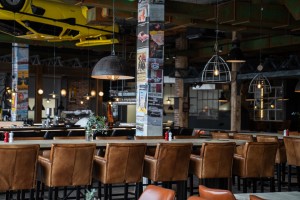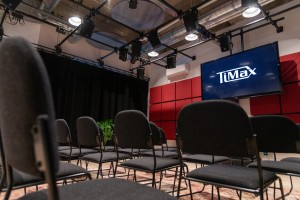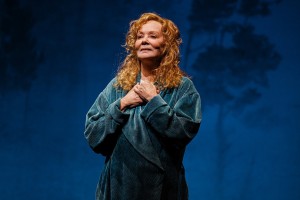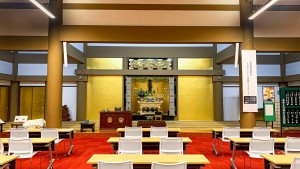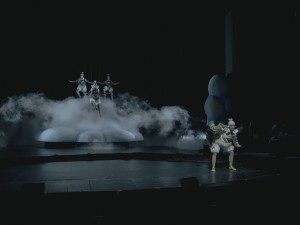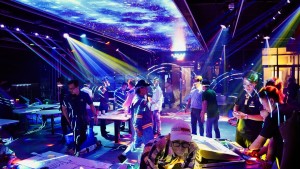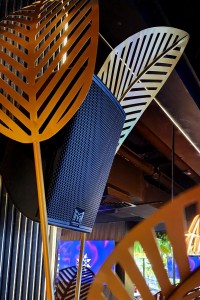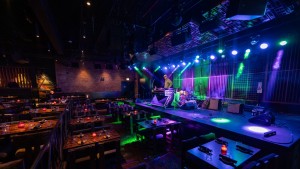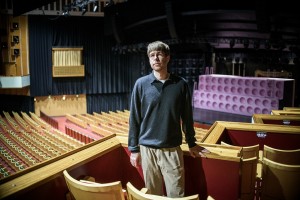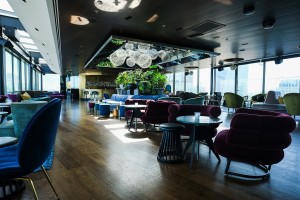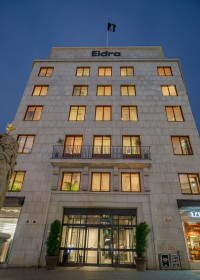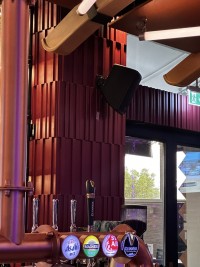Installationen News
Installationen News Schlagzeilen
Cpunt invests in Robe
27/06/2025
Alphatec supplies Coda Audio for VMS Delhi installation at new fine dining venue in Gurgaon, India
19/06/2025
Masque Sound collaborates with Dayglo Presents for systems integration at “Garcia’s Chicago”
03/06/2025
“We Will Rock You” Denmark uses DiGiCo
29/05/2025
iLux installiert LD-Systems-Lösungen in Motorworld Mallorca
Die im April 2025 eröffnete Motorworld Mallorca vereint automobile Leidenschaft mit Gastronomie und Eventkultur. Auf dem 80.000 Quadratmeter großen Areal eines ehemaligen Coca-Cola-Werkes, direkt an der Autobahn MA-19 zwischen Flughafen und Palma gelegen, entstand eine Erlebniswelt mit frei zugänglichen Ausstellungsflächen für Oldtimer, Sportwagen und Motorräder, Gastronomiekonzepten, Shops und Eventräumen.
Für die medientechnische Ausstattung der gastronomischen Bereiche im Herzen der kürzlich eröffneten Anlage - das Restaurant „Motorworld Inn“ und die Coffeebar „Motomio“ - zeichnete das Team von iLux Veranstaltungstechnik aus Deutschland verantwortlich, mit einem Audio- und Beschallungssystem von LD Systems.
Der Auftrag an iLux erfolgte über das Catering-Unternehmen Rauschenberger, das bereits an mehreren Standorten mit der Motorworld Group zusammenarbeitet. „Mit der Firma Rauschenberger verbindet uns eine langjährige Kooperation“, erläutert Enrico Rocca von iLux. „Nachdem wir bereits das ‘Motorworld Inn’ in München erfolgreich mit Technik ausgestattet hatten, wurden wir auch für das neue Projekt in der Motorworld Mallorca angefragt.“
„Dem Kunden war vor allem wichtig, dass die Technik den Gastronomiealltag erleichtert - nicht verkompliziert”, fügt Rocca hinzu. Die Lautsprecher sollten sich möglichst unauffällig in das vorhandene Designkonzept integrieren lassen und gleichzeitig in der Lage sein, den gesamten Bereich druckvoll zu beschallen. Um diese Anforderungen zu erfüllen, entschied sich iLux für Lösungen von LD Systems: Dqor-5-Installationslautsprecher kommen in Kombination mit strategisch platzierten Curv-500-I-Sub-10’’-Subwoofern zum Einsatz; als Verstärker werden IPA-424-T-4-Kanal-DSP-Installationsendstufen genutzt.
Auf Basis der Zone-X-1212-DSP-Matrix unterteilte iLux den Gastronomiebereich der Motorworld Mallorca in insgesamt zwölf separat steuerbare Audiozonen. Diese decken sowohl den Innen- als auch den Außenbereich des Restaurants sowie das angrenzende Café ab. „Für das Café, das eigene Musik und Öffnungszeiten hat, haben wir separate Zonen eingerichtet, die über einen QTP-Touchscreen gesteuert werden können“, erklärt Rocca. „So läuft im Café schon Musik, während im Restaurant noch Ruhe herrscht - ideal für Vorbereitungen oder Teammeetings.“ Über die QTP-5- und QTP-8-Screens kann das Personal die Lautstärke regeln, Signalquellen auswählen oder vorprogrammierte Szenen abrufen. Die Zuspielung der Inhalte erfolgt über zwei RSMP-Radio-Streaming-Media-Player.
Eine besondere Herausforderung habe die Installation an den Sichtbetondecken der Location dargestellt. Um die Dqor-Lautsprecher möglichst unauffällig und sicher zu montieren, setzte iLux auf speziell lackierte Gewindestangen und passgenaue Halterungen aus dem LD-Systems-Portfolio.
(Fotos: Motorworld Group/Thor Schoof)
TiMax and Sonosphere team up for new spatial studio London hub
TiMax Spatial Studios, based in London’s Tileyard, is the new HQ and studio space for TiMax. As the company celebrates the opening of its audio hub, TiMax also announces its collaboration with Sonosphere. Together the two companies will provide a flexible, multi-purpose, immersive audio London hub to demonstrate, educate, promote and deliver immersive audio systems, workflow and content.
The suite offers a 26.4.6 TiMax mixing studio, featuring TiMax SoundHub and its spatial audio and show control capabilities. TiMax Tracker D4 is installed with an eight-sensor system, and the studio also offers opportunities to work with TiMax PanLab, as well being configured as a 9.1.6 Dolby Atmos studio, which will be certified by Dolby in due course.
Completing the equipment roster are solutions from the wider Focusrite Group sister brands, including a suite of FlexPoint loudspeakers from Martin Audio, with amplification delivered via Linea Research 88C06 amplifiers with FlexPoint presets loaded. The combination offers an opportunity to create, design and deploy spatial audio content, whilst also providing a space for training and education, demonstration, hospitality and networking, showcases, panel discussions, and more.
“Since TiMax has come under the wing of the Focusrite Group, we have been able to quickly grow and evolve”, comments Rik Kirby, Commercial Manager for TiMax. “Our new London hub is the perfect manifestation of where TiMax is today. It coincides with a growing relationship with Sonosphere, demonstrated in the recent sell-out event, the Binaural Human, and we feel that our combined passion, skill and knowledge for spatial audio can help drive a thriving like-minded community.”
Duncan Bell, Commercial Director of Sonosphere, adds: “We work in all areas of immersive audio, be that recorded music, events or broadcast. We are delighted to be working with TiMax and this new studio as it not only enables us to add value to their activities but also enables Sonosphere’s own commercial opportunities to be fully realised too, under the banner of Sonosphere @ TiMax Spatial Studios.”
“The world is moving towards spatial audio at an ever-increasing rate, and the new studio will help accelerate this further”, concludes Kirby. “We are looking forward to welcoming the spatial community to our new home.”
(Photos: TiMax)
Masque Sound delivers integrated sound solution for Broadway show “Call Me Izzy”
Theatrical sound reinforcement, installation and design company Masque Sound provided a fully customized audio package to sound designer Beth Lake for the Broadway premiere of “Call Me Izzy”, a new production that recently opened at New York City’s Studio 54.
Written by Jamie Wax and directed by Sarna Lapine with scenic design by Mikiko Suzuki MacAdams, “Call Me Izzy” - a darkly comedic, one woman play - stars six-time Emmy Award winner Jean Smart. The project marks Lake’s first solo Broadway credit after previously co-designing multiple productions including “Camelot”, “Uncle Vanya” and “McNeal”, all of which featured Masque Sound’s support.
With an accelerated production timeline, “Call Me Izzy” required a flexible sound system for its text-driven, music-infused storytelling. “It was a fast and furious process”, says Lake. “Masque Sound was my first call. I reached out to Scott Kalata at Masque Sound, and he made it happen quickly and smoothly. There were a few equipment substitutions based on availability, but everything we needed came together without a hitch.”
While Studio 54 features a permanent sound system, Lake and her team, Associates Charles Coes and Megan Cully, successfully integrated a hybrid setup using elements of the house system combined with a custom rig from Masque Sound. “It was a great advantage to use some of the venue’s Meyer Sound under-balcony fills and surrounds”, notes Lake. “It allowed us to reduce load-in time while still achieving full coverage for the deep space.”
Lake built her system primarily around her speaker brand of choice, d&b Audiotechnik, paired with Meyer Sound components from the house. “We were able to achieve the sound I wanted for this production”, says Lake. “Masque Sound also provided me with a Yamaha DM7C digital mixing console and a Yamaha DME7 digital signal processor for delay matrixing and system processing, which is an essential element for the nuanced, music-infused production.”
The solo performance by Jean Smart required an unobtrusive wireless package. Lake selected a DPA 4061 Miniature Lavalier Microphone and DPA 6061 Subminiature Lavalier Microphones combo, paired with Shure Axient ADX1M Digital Micro Bodypack transmitters, for the 90-minute monologue.
With an original score composed by T Bone Burnett and David Mansfield, the production is nearly entirely underscored. “T Bone, David and I collaborated to shape the music to each dramatic beat”, says Lake. “The show is about language and the power of words, so ensuring intelligibility and texture throughout the theater was absolutely critical.”
“Call Me Izzy” opened on June 12, 2025, and runs for twelve weeks at Studio 54.
(Photos: Marc J. Franklin/Emilio Madrid)
Speaking Rock unveils new outdoor stage with all-Elation lighting system
Speaking Rock Entertainment Center has installed an Elation lighting rig for its new outdoor stage in El Paso, Texas. A cornerstone of the community’s live entertainment scene, the venue now features a 100-percent Elation lighting system designed to meet the demands of touring acts and large audiences.
Owned and operated by the Ysleta del Sur Pueblo (Tigua Indians), Speaking Rock offers free live music performances, even for big-name artists like Cypress Hill, Incubus, and Rieleros del Norte, where crowds exceeded 20,000. With a commitment to community access and premier performances, Speaking Rock is a cultural hub for music, entertainment, and celebration in the American Southwest.
Speaking Rock previously held events using its own non-IP-rated lighting but faced recurring issues. They ultimately decided to expand with a larger, more capable stage setup that would enhance production quality and meet professional touring specifications. “We decided to change up the whole lighting system as we wanted to do bigger events and host bigger names”, states Matt Velasquez, Production Director at Speaking Rock. “Free shows naturally attract large crowds and with the bigger acts come more demanding rider requirements.”
They considered renting the necessary gear but realized it wouldn't deliver the quality and control they aimed for. Instead, they invested in a full-scale stage setup, purchasing everything outright - including staging, audio, lighting, and the complete production package.
Elation’s Channel Market Manager, Esteban De La Torre, has a long-standing relationship with Velasquez and Speaking Rock lighting designer Efrain Gandarilla, who worked together at Elation dealer HB Electronics. He’s stayed in touch over the years, and when Speaking Rock began planning the upgrade, they shared their vision with De La Torre, who helped guide them in fixture choices.
“HB Electronics has been an important partner for many years and are our go-to partner for anything production”, says Velasquez, adding that he has trusted De La Torre’s opinion on lighting for years. De La Torre created a preview of the rig in Capture previsualization software, which Velasquez and Gandarilla then fine-tuned.
The lighting upgrade for Speaking Rock’s outdoor stage includes a lineup of IP65/66-rated fixtures built to withstand El Paso’s dusty outdoor environment. The full Elation rig includes twenty-four Proteus Hybrid Max, fourteen Proteus Brutus, fourteen Proteus Rayzor 1960, sixteen Pulse Panel FX, and forty-eight SOL I Blinder. The lighting system made its live debut on April 27, 2025, delivering a show for Mexican bands Rieleros del Norte and Los Huracanes del Norte. “I was happy and excited to use the rig for the first time for those two acts, and it was good to not have to worry about bagging lights”, says Velasquez. “Seeing the gear in action was everything I’d hoped for.”
The Proteus Hybrid Max, positioned in the rig, on truss stands and risers, with some on the ground for a floor package, can be used as a beam, spot, or wash light. It houses all-new technology like Fast Advanced Features, Tri-Tier Animation, SpinSync tracking, and a massive toolbox of visual FX. “We do a lot of rock shows and can use the beam for powerful looks on stage or can use it as a spot with slow movement and gobos for a pop show”, says Velasquez.
The Proteus Brutus, a 75,000-lumen-strong LED wash beam FX fixture, functions as a front wash light from a 26-foot throw. It provides full-stage coverage and allows a few units to be repurposed for floor package use as well. For the inaugural shows, guest designers used the Proteus Rayzor 1960 LED wash/mid-air/effect lights to wash the crowd, then zoomed in for tight beams, adding dynamic beam looks to the rig. They also took advantage of the fixture’s built-in macros, which streamlined their programming process.
As for the SOL I Blinders, Velasquez states: “They are versatile enough to use as strobes or crowd washes. I love that they can be linked together to create custom designs. For the first shows, we lined them across the top truss and lit up the entire crowd.” The Pulse Panel FX multi-dynamic effects fixtures weren’t used during the initial shows but will be integrated into upcoming productions. Velasquez notes that many of their country acts wear cowboy hats, which can cast shadows over their faces under the Brutus front lights. To address this, he plans to position several Pulse Panel FX units along the downstage edge for effective uplighting.
The venue plans to use the rig for dozens of concerts and special events year-round, from major rock, pop and country shows to MMA fights and themed entertainment. “For example, on the MMA fights, we used to use spots to light the ring, but now we plan on using the SOL I Blinders to give us some nice color around the entire ring, and we’ll use the Brutus to highlight the ring and other areas”, concludes Velasquez.
(Photos: Elation/Speaking Rock Entertainment Center)
Cpunt invests in Robe
Cpunt is a multi-purpose venue with several performance spaces in Hoofddorp right at the cultural heart of Haarlemmermeer in the Netherlands, just outside Amsterdam. Complete with two concert halls, a theatre, a flexible studio space and a library, it offers an entertainment programme including theatre, music, art and various related workshops.
Lighting for the main of the two “popodium” music spaces has recently been upgraded presenting an opportunity to get new moving lights onboard, which saw the addition of more Robe fixtures, a combination of eight LEDBeam 350s, eighteen Paintes and eight TetraX moving lights, all delivered by Robe’s Benelux distributor, Controllux.
Cpunt’s chief LX, Myron de Jong, has been working at the venue on and off for around fifteen years, starting as a volunteer when it opened, and continuing as a freelancer before taking up this full-time post. Initially there were no moving lights, then the first batch (not Robe) arrived during the first summer of operation. In 2015, with a previous lighting upgrade, the first Robe’s arrived on site in the form of LEDBeam 150s, ParFects and a mix of DL4X, DL4F and DL4S products, Robe’s first generation of theatrical style LED moving lights, all of which were installed in the 200-capacity Small Hall.
De Jong had looked at Robe back in 2012 because there were LEDWash 300 fixtures already installed in the theatre venue next door, which his crew service technically. “We liked these fixtures a lot and often borrowed them for dance parties in the other spaces”, he shares. As a result, they then purchased the LEDBeam 150s and DL4 series fixtures for the Small Hall, and these are all still working ten years later. By 2024, it was time to modernise the 800-capacity Main Hall lighting rig, so having enjoyed such success with Robe, they assessed current needs and looked at the brand again.
“The recent search for new products started with looking specifically for an LED spot light, together with a more powerful LED beam than the 150s”, explains de Jong. Then Controllux account manager Maikel Sakkers arranged a trip to the Robe factory in the Czech Republic. That’s where they saw the Painte and the TetraX and decided that these would be a perfect complement - as hard-edged and multi-functional units respectively - to the LEDBeam 350 which was already being considered. Additional advice was heeded from some key lighting designers including Patrick Krammer of Dutch rockers Bløf, who agreed that all these Robe products would be a great combination and choice.
The TetraXs are installed in the Main Hall on drop-down arms upstage. The LEDBeam 350s are providing side stage lighting in the Main Hall with some deployed above the audience for boosting crowd ambience or, from the same positions, doubling as stage washes. Lighting control in the Main Hall is an Avolites Arena.
Cpunt stages two or three major shows a week usually at the weekends. Most bands playing Cpunt will bring their own operators, and de Jong and his crew will light any who don’t.
(Photos: Louise Stickland/Paul Clarke)
Powersoft amplifiers power safety-first PA/VA at Elland Road stadium
A hat-trick of Powersoft amplifier platforms, including multiple models from the company’s Ottocanali series, are powering a new public address and voice alarm (PA/VA) system at the historic Elland Road stadium in Leeds, England.
Complemented by Unica- and Mezzo-series amplifiers, also from Powersoft’s fixed-install range, the Ottocanalis provide the amplification backbone for a safety-first, EN 54-certified PA/VA system delivered by UK-based system integrator ImPerium Integration.
Opened in 1897 and originally home to a semi-professional rugby league team, Elland Road has been home to three-time English football champions Leeds United FC since the club’s formation in 1919. Like many heritage stadiums in England, Elland Road’s lay-out betrays its humble roots, with different parts of the venue having been updated separately in the 128 years since its construction - the result being that its 37,792 seats are split unevenly between four stands, complicating the job of delivering a PA/VA system capable of providing even and consistent coverage across the entire stadium.
According to Alan Inkster, managing director of ImPerium Integration, Leeds United required a sound system that could ensure maximum intelligibility on match day while also provide the power and punch needed for concerts and live entertainment events. It also needed to be compliant with EN 54, the European standards for voice alarm and fire detection systems.
To supply the amplification backbone for this brief, Inkster and the ImPerium team turned to Powersoft’s Ottocanali range, specifying a total of twenty-four Ottacanali amplifier platforms (comprising Ottonacali 4K, Ottocanali 8K and Ottocanali 12K) to deliver 4,000, 8,000 and 12,000 watts of audio power respectively through eight channels to fans in the stands. The Ottocanalis are complemented by two Unica 4K8 amplifiers in the Pavilion banqueting hall, as well as a Mezzo 604 amplifier in the East Stand banqueting area. All Powersoft amplifier platforms are EN 54-certified for use in PA/VA systems.
The Ottocanali series is designed for mission-critical, multi-zone installations, with support for a wide range of system control, alarms, GPI/O and monitoring functions. The DSP models installed in Leeds also include on-board digital signal processing, offering enhanced flexibility while adhering the safety standards required by the club, with zoning provided by Peavey MediaMatrix servers (two Nion n3, two nCie Pilot, one sDAB 16i, and one sDAB 8x8).
At Elland Road, the Ottocanali amplifiers power eighteen Martin Audio Torus T1230 arrays in the North Stand, eighteen in the South Stand, twenty-four in the West Stand, thirty in the East Stand, and an additional twelve in the corners of the stadium. A further ten Martin Audio CDD12 loudspeakers are fitted at the rear of the West Stand for additional coverage, with Martin Audio SXCF118 subwoofers complementing the T1230s throughout.
Ceiling loudspeakers throughout all stands are EN 54-compliant Bosch EN54 models (180 in number), with an additional fifty RCF ceiling loudspeakers in the South Stand concourses and other areas. Also deployed at Elland Road: one Martin Audio CDD-Live, eight Martin Audio CDD5 and a Martin Audio Blackline X12, as well as forty Optimal Audio Cuboid 6 and twenty Optimal Audio Cuboid 5.
(Photos: ImPerium Integration Ltd)
Japanese temple Higashi Betsuin upgrades with Renkus-Heinz
The Nagoya Betsuin of the Shinshu Otani-ha is a historic temple located in Aichi Prefecture’s Nagoya City. Known as “Higashi Betsuin”, it has grown into a central place of worship in the Japanese region since its construction in 1632. As well as hosting Buddhist ceremonies and religious events, the temple is used for exchange events and markets, making it a meeting place for the local community. However, the building’s distinctive architecture comes with complex audio challenges, including intelligibility in the main hall.
To resolve long-standing acoustic issues and improve clarity for attendees, the Taimensho reception hall recently enjoyed a significant upgrade with the help of Renkus-Heinz distributor Beetech Inc., who installed an Iconyx Compact audio system. The reception hall is a large, traditional temple structure boasting a grand architectural style built with thick concrete. Buddhist sermons are delivered here every day, as well as large ceremonies. It’s a place of reflection and religious importance for both locals and tourists.
Around ten years ago, the building underwent a major renovation. Original tatami flooring was replaced with carpet laid over concrete, whilst shoji paper screens on the sides were changed to a more durable, tear-resistant material. The renovation, along with the temple’s previous loudspeakers, caused significant issues with reflected sound from walls and ceilings. The sound-absorbing properties of the tatami flooring and shoji paper screens were lost, leading to increased sound reverberation and a significant drop in speech intelligibility when using the PA system. A substantial upgrade was necessary for the temple to continue hosting sermons and other events successfully.
A representative from equipment supplier A&V Co. Ltd suggested Renkus-Heinz loudspeakers would be a suitable solution due to their narrow form factor and beam-steering technology. After conducting a demonstration with the Iconyx Compact Series ICC12/3, the decision was made to officially install the system. “With the introduction of the ICC12/3 system, we were able to deliver sound evenly throughout the room with minimal power”, a representative from the temple explains. “This reduced the need for excessive output to the rear, effectively helping to control reverberation.”
Where the temple’s previous sound system used portable loudspeakers, the new fixed installation needed to be mounted on the pillars. Due to the temple’s unique architectural design and structural limitations, installation locations were highly restricted and required careful consideration to achieve optimal audio performance. To address these concerns, the installation team designed custom mounting brackets that allowed the loudspeakers to be positioned as desired. The brackets were also engineered to be almost invisible behind the array, ensuring minimal disruption to the hall’s traditional appearance.
Hanging the speakers from the front pillars raised concerns about potential sound distortion; however, utilizing the ICC12/3’s beam-steering technology guaranteed minimal reverberation. The technology allowed integrators to freely adjust the output sound angle, allowing precise control over the focus and therefore minimizing echoes around the pillars. Furthermore, Renkus-Heinz’s Rhaon II software’s 8-band equalizer was used to adjust the acoustics to match the existing system for input devices such as wireless microphones and mixers.
(Photos: Renkus-Heinz)
Meyer Sound unterstützt neue immersive Klangkreation von Bill Fontana im Petersdom
In einer Verbindung von Kunst, Architektur und Audiotechnologie hat Meyer Sound die technische Grundlage für eine Installation des Klangkünstlers Bill Fontana geschaffen: „Silent Echoes of a Great Sound Sculpture“ heißt das Werk, das im Portikus der Basilika St. Peter in der Vatikanstadt installiert ist und das Unhörbare hörbar machen soll - die verborgenen Schwingungen des Campanone, der größten Glocke der Basilika.
Fontana, bekannt für seine Arbeit mit akustischer Resonanz und strukturgebender Vibration, zeichnete über hochsensible Sensoren die inneren Schwingungen der neun Tonnen schweren Glocke auf - Schwingungen, die dem menschlichen Ohr normalerweise verborgen bleiben. Mithilfe von digitaler Klangbearbeitung entstand daraus eine immersive Klanglandschaft, die - unterstützt von Ingenieuren des Ircam in Paris - täglich zu festen Zeiten über ein diskret in den Portikus integriertes Meyer-Sound-System abgespielt wird. Beim Betreten und Verlassen der Basilika durchqueren die Besucher den Säulengang - nun begleitet von Klängen, die den Moment der Stille und inneren Einkehr mit einer sinnlichen Klangwahrnehmung verbinden sollen.
Um die „Stille“ der Glocke in ein lebendiges, räumliches Erlebnis zu verwandeln, arbeitete Fontana mit Massimo Carini von MAC Sound S.r.l., dem italienischen Meyer-Sound-Vertriebspartner, zusammen. Zu Projektbeginn organisierte Carini für die Vatikanbeamten eine temporäre Demonstration der geplanten Installation vor Ort, bei der ein 4-Kanal-System mit Ultra-X20-Point-Source-Lautsprechern zum Einsatz kam. „Als die Kardinäle die Klänge des Musikstückes vernahmen, sagten sie: ‘So etwas haben wir noch nie gehört’“, erinnert sich Carini. „Es war sehr bewegend für alle.“ Nach der Freigabe installierte MAC Sound das vollständige System, bestehend aus acht Ultra-X20-Lautsprechern und vier USW-112P-Subwoofern, um die komplexen Texturen von Fontanas Komposition für die Besucher des Petersdoms in die Eingangshalle zu übertragen.
Fontana, einst Schüler von John Cage, versteht das Hören seit jeher als einen kreativen Akt - insbesondere durch das Erkennen von Mustern und Zusammenhängen. Für ihn stellt die ungehörte Stimme des Campanone eine Art Erinnerung dar - ein lebendiges Echo der Vergangenheit, das in der Architektur verhaftet ist. „Die massiven Kirchenglocken des Petersdoms sind dafür gebaut, zu vibrieren“, erklärt er und betont, dass sie selbst dann „zuhören“, wenn sie nicht läuten. „Und wenn Umgebungsgeräusche ihre Resonanzfrequenz treffen, antworten sie. Es ist ein sehr schöner, interessanter Klang.“
„Silent Echoes of a Great Sound Sculpture“ wurde von Umberto Vattani und Valentino Catricalà im Rahmen der Jubiläumsfeierlichkeiten des Vatikans 2025 kuratiert und soll bis Ende des Jahres bestehen bleiben. Es ist bereits Fontanas zweites großes Klangkunstwerk in Rom mit Unterstützung von Meyer Sound: Sein vorheriges Projekt wurde 2014 im Maxxi Museum installiert und untersuchte die akustischen Dimensionen antiker römischer Aquädukte. „Ich kenne Helen und John Meyer seit Jahren. Sie haben schon viele meiner Projekte unterstützt“, so Fontana. „Was ich an ihnen schätze, ist, dass sie nicht nur umwerfende Lautsprechersysteme und digitale Lösungen entwickeln, sondern auch sehr offen für kreative Ideen sind.“
(Fotos: Giorgio Maiozzi/Uthopia)
ETC Ministar in belgischem Luxus-Casino installiert
Das neue Silt Casino in Middelkerke an der belgischen Küste beherbergt neben dem Glückspielbetrieb auch ein siebzig Zimmer umfassendes Vier-Sterne-Hotel, ein Restaurant sowie eine Cabaret-Bühne. Um die Darbietungen im Varieté-Theater zu beleuchten, wurden rund dreißig Ministar-LED-Scheinwerfer von ETC über der kreisrunden Bühne installiert.
Lichtdesigner Jean-Philippe Corrigou war mit der Szenografie betraut. Über die Installation sagt er: „Das gesamte Projekt wurde in Rekordzeit durchgeführt und noch während der Einbauarbeiten um weitere Ideen ergänzt.“ Als Hürde erwies sich die relativ niedrige Decke und die runde, in der Bar integrierte Bühne. Die Scheinwerfer mussten diskret auf derselben Ebene wie die Tontechnik installiert werden.
In Kooperation mit dem Händler und Partner Novelty BVBA entschied man sich für ETC-Ministar-Scheinwerfer. „Wir haben zuerst mit dem Lonestar geliebäugelt“, sagt Corrigou. „Die kompakte Größe gab aber den Ausschlag zugunsten des Ministars.“ Auch die QuadraTech-Technologie des Ministar sei ein Erwerbskriterium gewesen: Die Farbräder können hier in Quadranten angeordnet werden; 64 verschiedene Kombinationen sind möglich, durch das Hinzufügen von Gobos erschließen sich weitere visuelle Optionen.
„Bei diesem Farbsystem durchläuft das Licht weniger dichroitische Filter, was zu kräftigeren Farben führt“, so Corrigou. Per Tastendruck sind sowohl bei Washes als auch bei Aerials visuelle Effekte realisierbar. Auch das Weißlicht des Ministar habe Corrigou überzeugt: „Mit unseren früheren HMI-Quellen hatten wir jede Menge unterschiedliche Weiß-Töne“, sagt er. „Das ist jetzt nicht mehr der Fall. Die Farbtemperaturen und Helligkeitswerte der Scheinwerfer sind jetzt einheitlich.“
(Fotos: ETC/Jonathan Grimaux/Damien Chicot/Jade Production)
Penguin revamps Laine Pub Co sound with Martin Audio
Martin Audio partner Penguin Media Solutions recently completed the third technical overhaul of pubs in the burgeoning 50-plus Laine Pub Company estate. Both organisations are HQ’d in Brighton, UK, and Penguin’s Technical Project Manager Dylan Thompson says that since all three city centre pubs have their own identity and autonomy an individual approach was required when it came to specifying audio. Thompson turned to Martin Audio, whose portfolio afforded different options.
Penguin’s latest implementation was the “Black Lion”, a popular music pub nestled in Brighton’s Lanes. The client required better traffic flow to draw its clientele towards the rear of the room - where the intensity would increase - and avoid the current pinch point at the front. “The previous design was a bit lazy, with lots of mismatched 8-in boxes scattered around and a sub that wasn’t doing much”, says Thompson. “It all sounded a bit samey and thin, and we were asked to give it personality.”
Placing both the acoustic and visual focus on the DJ, Penguin designed a new cast concrete booth, equipping the compact domain with a Blackline X12 as reference monitor and SX215 subwoofer on anti-vibration mounts. Either side are now a pair of FlexPoint FP12s and eight Blackline X8 for general room fill. Explaining his selection, Thompson says: “I didn’t want to go much smaller than that because I wanted to keep a nice warm mid-bass running through and we didn’t have many options for sub placement. I really like the whole FlexPoint range.”
To this he added a pair of Blackline X210 subs - one flown to place it in the required location, and another under the banquette seating at the front - all driven by two sister brand Linea Research 88C10 amps. Sound is routed via an existing Soundweb venue matrix, with DSP handled within the Linea environment. Another of Martin Audio’s sister brands, Optimal Audio, comes into play outdoors where sixteen Cuboid 3T (with IP kit) are installed.
The entire venue is then controlled via Penguin’s bespoke app, developed in-house. “By using third-party control with a web app - and not platform specific - the supervisor, manager and DJs can control the lighting”, says Thompson. “There is a little tablet in the booth to trigger the presets, and levels and source for each zone can be controlled for on the same app.” This was part of a larger project in which the integrators designed and installed pixel lighting - industrial looking tubes behind and above the DJ, with flush plastered profiles for the arches, and recessed profiles for wall washing.
Less than a year earlier Penguin Media Systems had carried out their first installation contract for Laine, after being recommended. This was “The Hope & Ruin”, described as a grassroots live music venue. Penguin’s recommendation was the Martin THS 15-in triaxial point source speaker, and a pair of SX215 subwoofers now feature at the front of the stage, replacing an ageing system that had become unreliable. At the same time they provided the venue with four LE100 artist reference monitors.
Having passed their induction, Penguin were then offered the “Dead Wax Social”, another city centre pub. Here Thompson made the decision to roam off grid, specifying a pair of Martin Audio Screen 4s, originally designed as a cinema system, in newly fabricated custom flying frames.
Thompson’s rationale in recreating a ’70s listening bar theme was entirely logical, as he explains: “We played about with them and did a bit of voicing change to suit the creative brief and aesthetic from Rob Hall at Laine; we also turned them horizontally in their new frames to make them look even more eye-catching as well as gaining space.” He also painted the baffles, and in their new hammered green finish, the speakers have now become a visual focal point as well.
(Photos: Martin Audio)
Alphatec supplies Coda Audio for VMS Delhi installation at new fine dining venue in Gurgaon, India
“Koca” is the latest addition to the culinary landscape in the Indian city of Gurgaon. The first restaurant venture of Indian cricket player Yuvraj Singh, “Koca - Kitchen of Celebratory Arts” is a fine dining establishment characterised by contemporary interiors and a high-energy experience.
Background music is a key element of the atmosphere, as are the DJ sets which are a feature of the venue. The “Koca” team engaged supplier Alphatec and integrator VMS Delhi, led by technical lead Sandeep Duggal, to provide a solution befitting the status of the venue.
The team chose a Coda Audio system for the interior areas of “Koca”. With no place for traditional bulky speakers, Alphatec supplied a combination of Coda Audio Hops8i (8’’ high output point source) and G308-Pro (compact 8’’ multi-design system) loudspeakers, supported by G15 and G18 multipurpose sub extensions. The system is driven by Coda Audio Linus 6.4i amplification.
(Photos: Coda Audio/Koca)
Cast liefert MDG-Bodennebelmaschinen an Schauspielhaus Bochum
Das Schauspielhaus Bochum ist seit mehr als einhundert Jahren eine der führenden Spielstätten für zeitgenössisches Theater und darstellende Kunst in der deutschsprachigen Theaterszene. Seit der Spielzeit 2018/2019 steht das Haus unter der Intendanz von Johan Simons.
Speziell für die neue Inszenierung des Stücks „Nils Holgersson“, welches weitgehend „über den Wolken“ spielt, war das Technik-Team des Schauspielhauses auf der Suche nach Bodennebelgeneratoren. „Für uns war es essenziell, dass der Bodennebel kontrollierbar bleibt und sich nicht unkontrolliert im Bühnenraum verteilt“, erklärt Wolfgang Macher, Beleuchtungsmeister am Schauspielhaus. „Wir haben in der Vergangenheit bereits mit anderen Maschinen gearbeitet, aber der Nebel hat uns nicht überzeugt. Die Standzeiten des Nebels waren oft zu kurz und aufsteigender Nebel behinderte die Sicht auf das Bühnenbild.“
Christian Pies von Cast, ein langjähriger Lieferant des Schauspielhauses, führte im Herbst 2024 den MDG-Bodennebelgenerator Ice-Fog Compack-H vor. Eine Demo mit Hindernissen, wie er sich erinnert: „Ich kenne die Maschine gut, habe sie schon oft vorgeführt. Ich weiß, was ich zu erwarten habe, wenn ich sie einschalte. In Bochum war aber zunächst alles anders. Kaum Bodennebel auf der Bühne zu sehen. Unfassbar! Im Rahmen der Ursachenforschung fielen uns dann große Spalten im Bühnenboden auf, die den Nebel weitgehend geschluckt hatten. Der Bereich unterhalb der Bühne war jedenfalls erstklassig benebelt.“
Nachdem die Bodenspalten abgeklebt waren, erzielte die Ice-Fog Compack-H den erwarteten Effekt und überzeugte die Lichttechnik-Abteilung des Schauspielhauses. Im Oktober wurden die ersten zwei Geräte ausgeliefert, im Dezember folgte die dritte Maschine. „Wir haben die Geräte gezielt für unsere große Bühne angeschafft“, sagt Macher. „Mit drei Maschinen können wir den Nebel aus verschiedenen Positionen steuern und jederzeit ein gleichmäßiges Bild erzeugen.“
(Fotos: Fabian Ritter)
Tateside’s partnership with Halkin scales up at new Euston workspace
Halkin has enjoyed a close and evolving relationship with AV integration specialists Tateside in London. What began with small-scale installations has gradually expanded as Halkin’s footprint grew. One of their largest collaborations to date is at Halkin’s new prime location at Mainframe Euston, marking the workplace brand’s ninth location.
Mainframe is a fully renovated building featuring three floors of office and co-working environments in London’s Knowledge Quarter. It also offers a multi-functional event space. To match this flexibility, the AV systems had to be capable of supporting different types of use throughout the day. The project scope ranges from global background audio to meeting room systems and sub-divisible room AV set-ups.
All three floors were equipped with Bose background audio systems, divided into two to three audio zones per floor to create tailored ambience. These zones are controlled from an iPad located at reception, so staff have the ability to manage the audio environment across the entire site. “Being able to manage all floors from one interface was key”, says Jack Cornish, Technical Director at Tateside. “Staff needed accessible control without any level of technical know-how and most people are comfortable using an iPad.”
In terms of content, the background audio is based on a license-free music playback system. The playlist, which is curated by Ollie Humphreys at Soundscape, plays throughout the shared and transitional spaces in the building without the need for a PRS music license. “It’s designed for those ‘in-between’ areas, places where you don’t want silence, but you also don’t want to pay commercial music licensing fees every year”, explains Cornish.
For the hard of hearing, Tateside introduced an IR hearing loop system in key areas, ensuring accessibility. “We couldn’t install traditional floor loops in some spaces due to building constraints”, continues Cornish. We opted for a Williams Sound system instead.”
The core focus of the Halkin project was its various meeting rooms. Establishing a technology standard, six meeting rooms were installed with Neat Board Pro systems, each configured for use with Zoom Rooms software, the clients’ preferred conferencing solution. Each space is equipped with a Neat Pad booking panel for room scheduling. Ashton Bentley BX breakout hubs, mounted under the desks, give full BYOD functionality.
The most technically demanding and rewarding space to fit out was Halkin’s subdivisible event room on the ground floor. This space can be used as one large room or split into two smaller meeting rooms. Intelligent automation was required to ensure the rooms could switch quickly between modes, whilst maintaining a familiar user experience.
Each half of the room is equipped with four cameras, eight in total across the space, which operate in sync when the room is opened into a single open configuration. Audio is provided by Sennheiser Dante-enabled ceiling microphones and a combination of ceiling and pendant-mounted Bose loudspeakers. The entire system runs on a Q-Sys backbone for DSP and control. “The divisible room was the main technical challenge”, confirms Cornish. “Getting camera switching, audio behaviour, and screen content to adapt to the room’s physical state required tight integration between hardware, software, and the architectural layout.”
Each room runs on Yealink’s S90 Zoom Room system, which includes a dedicated mini-PC, AV hub, room sensor and touch panel. One feature is the interface design, where users can start with a basic room control interface or swipe across the touchscreen to access a deeper Q-Sys user interface for more granular control if needed.
When in open mode, the room features two 98-inch displays at either end and a delay screen on a mobile trolley for extra visuals when required. Using the sensor on the partition wall in the middle, the AV system automatically switches to the desired mode and connects to the appropriate room peripherals based on the behaviour picked up by the sensor. Lightware’s Taurus UCX handles signal management, connecting users’ devices via a USB-C to the room peripherals in each divisible space instantaneously, including all video and audio elements, while providing device charging at the same time.
(Photos: Tateside)
Hoang Phu Sound installs Powersoft T Series amplifier platforms at “Sky Bar” in Vietnam
Powersoft’s T Series amplifiers were chosen to drive a sound system at “Sky Bar”, a rooftop venue in Ba Ria Vung Tau, Vietnam. With views of the coastline and a dynamic nightlife, “Sky Bar” now boasts audio setup for live events and high-energy entertainment.
Located on the top floor of the four-star Premier Pearl Hotel, “Sky Bar” offers panoramic views of Vung Tau’s ocean and city. To match its visuals, the venue needed a high-power sound system that would also withstand the harsh coastal conditions, such as wind and sea salt.
Tasked with the installation was Hoang Phu Sound, also a consultant on the project and a partner of Universal Procurement Systems Vietnam Co. Ltd (UPSV), Powersoft’s distributor in Vietnam, which chose Powersoft’s T Series amplifiers and Bose Professional speakers.
Hoang Phu Sound installed Powersoft’s 8000 W, four-channel T904A and two 6000 W, four-channel T604A amplifier platforms. The T Series were installed in the central equipment rack, near the bar area, for easy access for maintenance and monitoring.
Accompanying the Powersoft amplifiers were Bose AMU208 full-range speakers and Bose MB210WR subwoofers (Bridge Mode in Powersoft T604A). The system tuning and adjustments were done via Powersoft’s ArmoníaPlus System Design software.
(Photos: Powersoft/Hoang Phu Sound/Sky Bar)
Exacting Diseno unite Martin Audio family at Coco Dubai
Lou Agha’s system integration company, Exacting Diseno Technical Services, are fast gaining a reputation for installing Martin Audio sound systems in some of Dubai’s smartest upmarket bars and lounges. Working closely with territorial distributors Pro Lab, they recently equipped “Coco Grill & Lounge” for owner Naz Choudhury, whose concept is to integrate a Shisha Lounge with Dubai’s first Redemption Bar.
It follows the operator’s initial launch of the “Coco” brand in London, overlooking Tower Bridge, and offers the same views from its downtown location, this time of the Burj Khalifa. All operations are alcohol-free, with upscale mocktail bars. Lou Agha had been introduced to the project via a consultant. “When the client asked what sound systems I used, he was pleased it was Martin Audio, as this was the brand he was using in London.”
Agha first arranged a demo at Pro Lab of various CDDs (up to 8 in) and FlexPoint. “We started with the small FP.” He then quoted in various configurations, recommending CDD6 for the venue’s low-ceilinged interior and fourteen Blackline X8 for outdoors which combines Shisha Lounge with DJ and small combo live acoustic music, with vocalists, in a non-stop entertainment package. The unit is divided into nine separate zones, all networked on a Dante backbone. The fourteen Blackline X8 are complemented by six Martin Audio SX112, while six pre-existing Adorn A55 have been refurbished and added - four on one side, two on the other.
At the entrance, another pair of Adorn A55 and single SX110 sub beckon customers in, and as they enter the Dome, they are greeted by six FlexPoint FP8 speakers, with four SX112 subs. “Inside, the client wanted high quality music to be extended to the toilets”, says Agha. “So we have Adorn ACS 40TS ultra-compact ceiling speakers running at 16 ohms.”
The lounge features two non-smoking areas: one contains four CDD6 and two SX110, while the other has six CDD6 and two SX110. In Smoking Area 1 are a further four CDD6 and two SX110; Smoking Area 2 has two further CDD6 and a single SX110; and Smoking Area 3, which can also be rented for private occupancy, is equipped with four CDD6 and two SX110.
Agha says that in order not to intrude on the general aesthetic of the lounge, the subwoofers are placed discreetly. “I used the SX110 rather than the SX210 because of space constraints”, he says. “For that reason I couldn’t put the SX210 on its side, so I separated them into pairs of the SX110.” By day the venue’s background music operates off a Spotify playlist, common to both London and Dubai - programmed by one of their DJs, with a theme heavily weighted towards the popular Afro Beats. Routing and DSP are under the management of a Xilica FR1.
(Photos: Martin Audio/Coco Dubai)
L-Acoustics L Series helps transform Alpexpo’s “box in a box” venue vision into reality
When Alpexpo recognised that event organisers needed something between Grenoble’s massive arena and an intimate live venue, they decided to design a “box in a box” concept that carves out a 3389 square meter auditorium within their existing Greater Hall, powered by an L-Acoustics L Series professional sound system.
This architectural feat transforms what was once a traditional exhibition space into a chameleon-like venue that adapts seamlessly between intimate seated concerts for 1,495 people and energetic standing shows for 2,100. “They wanted to build a complete auditorium inside their existing hall”, says Antoine Maurel, Sales & Installation manager at L-Acoustics Certified Partner M+ Equipment, part of M Group. “Our challenge was creating an adaptable system that could be everything to everyone.”
The challenge went beyond mere logistics. For over five decades, Alpexpo - a venue with Olympic heritage dating to 1968 - has served as one of the Alps region’s premier event destinations. But evolving audience expectations and a growing demand for venues that could handle everything from stand-up comedy to hybrid and immersive multimedia experiences, the traditional approach no longer sufficed.
“With the existing attachment points, we needed to have a lightweight and efficient system adapted to the type of events, hence the L2”, says Maurel. The answer came through the weight-to-power ratio of the L Series meaning the team could deploy a full concert-grade line array system: two L2D arrays as the main system, complemented by three flown KS21 subwoofers per side in cardioid configuration. A centre cluster featuring A10 Wide and A10 Focus speakers ensures the desired coverage for the first audience rows.
“The L Series gave us something we couldn’t achieve before”, furthers Maurel. “Through advanced DSP processing, we can completely transform the acoustic environment. No manual intervention - just instant adaptation to whatever the event demands.”
The installation includes monitoring solutions with permanently hung A10 speakers and mobile X8 units, plus six additional X8 speakers for stage lip coverage when needed. Every element was modeled using Soundvision software. The entire project - from initial concept to opening night - was completed in just a few months, with M+ Equipment working alongside Alpexpo’s team to ensure the deadlines were met.
By creating a sophisticated performance space within an existing structure, the Alpexpo team has not only solved their own challenge but provided a blueprint for other venues facing similar constraints. “It’s not just a sound system; it’s a complete ecosystem that reflects our venue’s ability to adapt and excel”, says Jérôme Riff, Managing Director of Alpexpo. “We’ve created something truly unique for the Grenoble region - a space that can be whatever our community needs it to be.”
(Photos: Alpexpo/Princesse Photographie)
Ruth and Nathan Hale Theater equipped with Elation lighting rig
The Ruth and Nathan Hale Theater, also known as The Ruth at DoTerra, opened its doors on January 4, 2025, as a performing arts venue. A culmination of years of planning, the new venue in Pleasant Grove, Utah, is equipped with Elation’s latest lighting technology.
The venue houses two theaters, the 670-seat Scott and Karen Smith Grand Theater and the 300-seat Lindsay Legacy Theater. Elation lighting graces both theaters, including 40 Artiste Monet luminaires and 88 KL Profile FC fixtures, supplied by Barbizon Light of the Rockies, and 103 Fuze Pendant Compact fixtures, sold by Elation dealer Brio Technologies. Michael Gray, head of lighting at The Ruth, specified fixture types and quantities.
The theater operated for 35 years as the Hale Center Theater Orem, a small semi-professional theater-in-the-round with a 300-seat capacity. Over the years, it searched for a larger venue to accommodate its growing patron base. DoTerra, a local company in Pleasant Grove, donated land and funding, enabling the theater to construct a new facility on the DoTerra campus. In November 2022, construction commenced, and after a two-year build, the Ruth and Nathan Hale Theater was completed. Besides the two theaters, the facility also houses an education center, multiple studios, a ballroom, a VIP lounge, and administrative and support spaces.
Troy Anderson, Director of Operations at The Ruth, served as project manager, working with architects Method Studio and contractors to realize the space. The Shalleck Collaborative served as the theatrical consultants. Anderson also led the technical aspects of the project, including the execution of the lighting installation. His collaboration with Barbizon, Brio, and Elation representatives William Irwin and Nick Saiki helped bring the vision to life.
The Ruth’s lighting system was designed to meet the demands of a theater that hosts performances six days a week. The Artiste Monet allows Anderson and his team to use it as a followspot, a static washlight, a moving head, or an effects light, “all in the same production”, he notes. Elation’s KL Profile FC also played a critical role in the decision-making process: “The adjustable lensing and the range of features that come with the KL Profile were key in its choice”, says Anderson. Both fixtures were earmarked for use in the Smith Grand Theater.
The Fuze Pendant Compact was selected as the house light for both the Grand Theater and the Lindsay Legacy Theater, a decision that came after an initial house light specified for the venue turned out to be white light only, which didn’t meet the theater’s needs. “We use a lot of color in our house lighting”, says Anderson. “As patrons enter the theater, we want them to feel like they’re already part of the set and the show. The tones and colors we get from the Fuze Pendant match with our other lighting fixtures.”
At the heart of The Ruth is the Scott and Karen Smith Grand Theater, a 10,000-square-foot space with a proscenium thrust that has the added flexibility to be adapted to a full theater-in-round, accommodating an additional 100 seats. The Lindsay Legacy Theater is designed to mimic the original intimate venue that its patrons have loved for three decades.
While most of the Artiste Monet and KL Profile fixtures are used in the Smith Grand Theater, which features a nearly 100% Elation rig, in the Lindsay Theater, most of the lighting was repurposed from the original Orem facility and supplemented with the Fuze Pendant house lights and a few of the Artiste Monets and KL Profiles.
In the Smith Grand Theater, catwalks and the lighting rig encircle the stage in multiple tiers, with an inner ring and outer ring of lights. Michael Gray’s goal in creating his initial lighting rep plot, Anderson says, was to hit every point on stage from at least four angles: “The way we light our shows is different from a traditional proscenium setup. In theater-in-the-round, you need to light the stage from multiple angles to ensure every point is covered. That also increased the number of fixtures we needed.”
The Ruth installed the Elation lights themselves, completing the setup just before “Ragtime”, the first play in the Smith Grand Theater, opened on December 20, 2024. The theaters maintain a packed schedule, with performances running Monday through Saturday and up to four shows staged daily. “Cinderella” plays in the Lindsay Legacy Theater until May 3, 2025, while “Jersey Boys” opened on March 28 in the Smith Grand Theater.
(Photos: The Ruth and Nathan Hale Theater)
Masque Sound collaborates with Dayglo Presents for systems integration at “Garcia’s Chicago”
Masque Sound, a theatrical sound reinforcement, installation and design company, has announced its systems integration for “Garcia’s Chicago”, a new restaurant and live music venue inspired by the enduring legacy of Jerry Garcia.
The venue was developed by live music and media company Dayglo Presents which brought in Masque Sound to bring its technical vision to life. Jesse Lauter, Head of Production & Media at Dayglo, spearheaded the collaboration and has worked with Masque Sound on projects for more than a decade.
“I have this great relationship with Matt Peskie and the entire team at Masque Sound”, says Lauter. “When Anthony Nittoli joined Masque Sound as Installation Division Manager, it was a match made in heaven. Anthony has always been my go-to for design and concept, so having so much talent under one roof was fantastic.”
The project presented some challenges, including a pre-determined booth placement and design limitations set years earlier. “We were locked in on positions and placements that weren’t ideal”, says Lauter. “But, through close collaboration between Meyer Sound and Anthony at Masque Sound, we overcame those obstacles.”
Masque Sound’s work included a full systems integration featuring a Meyer Sound loudspeaker system comprised of seven Ultra X-40s, seven Ultra X-20s, two 900-LFC subwoofers, one 750-LFC subwoofer and six MJF-208 stage monitors. “The choice of Meyer Sound was both technical and symbolic”, says Lauter. “Meyer’s history with the Grateful Dead made them a natural fit.”
This system was anchored by a Yamaha DM7C-EX digital console with Rio 3224-D2 and Rio 1608-D2 stage boxes. A range of Shure, Audix and Sennheiser microphones paired with K&M stands supported the venue’s input needs. For video capture, the venue was equipped with five PTZ Optics 4K HD cameras operated via a PTZ Optics controller, allowing seamless content creation and livestream capabilities.
“Masque Sound also supported the venue through its opening nights and was great in commissioning the system and staying onsite to ensure seamless operation”, adds Lauter. He also praised the efforts of Peter Shapiro, Owner of Dayglo Presents, and Kim Kozak, Production Manager, who both played crucial roles in the realization of “Garcia’s Chicago”.
(Photos: Masque Sound)
WSDG realisiert Akustiklösungen für Klassikstudio von Headstart Records in Wien
WSDG, ein weltweit tätiges Ingenieurunternehmen für Akustik und Medientechnik, hat für Headstart Records, ein Studio für die Produktion klassischer Musik mit Sitz im Herzen Wiens, ein Projekt zur Verbesserung der Akustik abgeschlossen.
Durch die Zusammenarbeit mit renommierten Ensembles wie dem Arditti Quartett, dem Chamber Orchestra of Europe und den Wiener Philharmonikern sowie mit Labels wie Deutsche Grammophon und Decca Classics hat sich das Studio zu einem Zentrum für die Bearbeitung und Produktion klassischer Musik entwickelt. Die Gründer Benedikt David und Ina Nikolow absolvierten das Tonmeister-Programm an der Universität für Musik und darstellende Kunst in Wien und erhielten eine zusätzliche praktische Ausbildung am Banff Centre for Arts and Creativity in Kanada. Als Produzenten und Tontechniker sind sie bei der Aufnahme klassischer Musik mobil und anpassungsfähig.
„In unserem Bereich gibt es so viele verschiedene Besetzungen in Bezug auf Genres und Instrumentierung, und die Musik wird erst in einer geeigneten Akustik richtig lebendig“, sagt David. „Deshalb bringen wir unser Aufnahmeequipment an Orte, die perfekt zu dem Ensemble und seiner musikalischen Vision passen. Mit diesem Ansatz können wir problemlos an jedem beliebigen Ort aufnehmen, sei es ein Konzertsaal, eine Kirche oder ein Theater.“ Jeder Aufnahmetag erfordert eine mehrtägige Nachbearbeitung, die Editieren, Abmischen und Mastern beinhaltet. „Die Nachbearbeitung ist ein großer Teil unserer Arbeit“, so David. „Für das Mischen und Mastern brauchen wir einen Regieraum, auf den wir uns klanglich verlassen können, denn was wir als Referenz hören, ist das, was das Label am Ende des Prozesses veröffentlicht.“
Auf der Suche nach einer geeigneten akustischen Lösung wandte sich Headstart Records an WSDG, ein Unternehmen, das dem Studio bereits von der Arbeit in anderen Wiener Studios bekannt war. „Als ich im Sunshine Mastering arbeitete, das von WSDG entworfen wurde, war ich von der akustischen Klarheit beeindruckt - ich konnte alles sehr detailliert hören, was meine Arbeit sehr erleichterte“, sagt David, der ebenso wie Nikolow auch an der Universität für Musik und darstellende Kunst Wien unterrichtet - dort war WSDG ebenfalls maßgeblich an der akustischen Gestaltung mehrerer Studios und Regieräume beteiligt. „Deshalb lag es nahe, mit ihnen zusammenzuarbeiten“, sagt Nikolow.
Das Projekt war mit besonderen Herausforderungen verbunden. Die Integration des Studios in ein historisches Wohngebäude erforderte maßgeschneiderte akustische Lösungen, die den Charakter und die Substanz des Bestands bewahrten. „Wir brauchten einen Raum, der sowohl aus akustischer als auch aus ästhetischer Sicht perfekt funktioniert“, so Nikolow.
Das Team von WSDG bestand aus Projektkoordinator Dirk Noy (Partner, General Manager Europe), Gabriel Hauser (Partner, Director of Acoustics) und Collin Killenberger (Projektingenieur) sowie Mario Reithofer (Business Development). „Vom ersten Treffen mit WSDG an hatten wir das Gefühl, dass Dirk und Gabriel wirklich verstanden haben, was wir tun und was wir für unsere Arbeit brauchen“, sagt David. "Wir wussten, dass das Unternehmen Erfahrung im klassischen Bereich hat, und das war für uns sehr wichtig.“ Nikolow ergänzt: „Wir wollten einen ruhigen, einladenden Raum mit klarer Gestaltung - einen Ort, der kreatives Arbeiten über Stunden hinweg ermöglicht, an dem die Technik im Hintergrund bleibt und die Kunst im Vordergrund steht.“
Das Studio ist mit warmen Materialien ausgestattet, etwa mit Holz-Wandverkleidungen. Ein abgehängtes Deckenelement sorgt für die Kontrolle der Erstreflexionen, während Stauraumlösungen unsichtbar hinter Wänden und Diffusoren rund um den Mischplatz verborgen sind. „Wir mussten eine Menge Geräte und Dokumente unterbringen“, sagt David. „Das war vielleicht die größte Herausforderung: die akustischen Elemente wirksam und schön zu gestalten und gleichzeitig viel Stauraum in das Design zu integrieren. Wir schickten einige Skizzen hin und her, mit verschiedenen Variationen über das Gleichgewicht von akustischer Effizienz und Lagerraum; letztendlich entschieden wir, dass die Akustik die Priorität sein sollte.“
Die akustische Einrichtung fokussiert auf kritische Hörparameter für die Produktion klassischer Musik und bietet eine präzise räumliche Bewertung des Stereopanoramas und eine genaue Tiefenplatzierung der Schallquellen - beides Schlüsselanforderungen für die Arbeit von David und Nikolow. „Das Upgrade war viel größer, als wir erwartet hatten“, sagt David. „Die räumliche Klangwiedergabe ist jetzt wesentlich detaillierter. Mit dieser Detailgenauigkeit ist es, als würde man akustisch durch ein Vergrößerungsglas schauen. Jetzt kann ich Elemente hören, die ich vorher nicht wahrnehmen konnte.“
Als Referenzmonitor kommt der A25-M von PSI Audio zum Einsatz. Er ist in der Lage, Klangquellen jeder Größenordnung, von Soloinstrumenten bis hin zu großen Symphonieorchestern, zu reproduzieren.
Personenfoto: Dirk Noy, Benedikt David, Ina Nikolow und Mario Reithofer. (Fotocredits: Katja Fickenwirth/Dirk Noy/WSDG)
“We Will Rock You” Denmark uses DiGiCo
The “We Will Rock You” musical is a worldwide success and, since opening in London in 2002, numerous versions have been staged in every corner of the globe. For the most recent version in Denmark, sound designer and Head of Sound, Magnus Hansen (pictured), has made full use of the DiGiCo SD7 T console personalisation.
The new Danish translation of “We Will Rock You” opened in the Tivoli Concert Hall in Copenhagen ahead of a nationwide tour, and is produced by Lion Entertainment. The DiGiCo SD7 T at front-of-house is accompanied by a Quantum 338 and Klang at the monitor position, and SD7 T in the redundant mix room, all supplied by DiGiCo dealer Lydfabrikken.
The show is renowned for its fast-paced scenes, with over twenty Queen hits featured throughout. There are twenty people in the cast and five in the band, twenty IEM channels, sixty mic channels, wireless MIDI, wireless cameras, plus sound effects, mixing and timing of cues for the engineers to concentrate on. The band are located in two huge boxes that move around the stage, with musicians performing wirelessly.
There are three show staff - Lukas Ockelmann, Oliver Svensson and Tobias Vohnsen - accompanied for the rehearsal period by Frank Grønbæk in the redundant mix room, Alistair Kerslake on monitors, and supported by sound designer Magnus Hansen. By adding extended automation to the basic audio-structure at front-of-house, the sound team have been able to refine the mix, ensuring that FOH engineer Lukas Ockelmann is free to connect with the cast and band on stage.
“We had just eleven days on location with full technical and creative support to assemble the whole show, including previews”, says Magnus Hansen. “We wanted to find a way to really use that time effectively, not just to prepare everything technically, but to maximise our creative time with the rest of the design team. We were looking at the Snapshot and Macro functionality of the consoles and realised that if we had a whole redundant system in another room, we could record sections of the show and work on the mix separately, but simultaneously.”
“While Lukas was mixing and cueing rehearsals live, Frank was mixing the songs in a separate room”, he continues. “I was able to keep a full overview and make final adjustments to streamline the design. Once rehearsals were over for each day, we merged the show files and then built on this hard work each day.” Having worked with Lion Productions for almost a decade, Hansen has developed a strong relationship with the rest of the team.
“It is very important to understand that we are aiming for a high level of detail in the mix”, he furthers. “With this method, the whole backbone of the mix is programmed in. We can utilise the Snapshots to pre-programme tiny changes in reverbs, effects or dynamics, which means Lukas can really focus on riding the faders like an instrument, shaping the natural dynamics in real time. On average, we have about twenty Snapshots per song, but it is not 100 percent, fingers still work a lot on the faders. But now, movements are comfortable, in both the loudest and quietest parts.”
The Snapshots are triggered automatically via timecode, so Ockelmann can trust that the changes are happening exactly when they are needed, while still maintaining control of the overall mix. In order to alert engineers to a long sequence of automation, the team have also programmed colour-coded changes to avoid accidental button pushes. When a sequence is in progress, the Snapshot background will show in red, and then return to normal colouring once the sequence has completed.
The team are also taking advantage of the text formatting, changing the typeface to bold or italic, depending on the type of cue. “For example, we can use blue-italic for MIDI cues, thin type lower-case for dialogue, and bold caps lock text for songs”, says Ockelmann.
(Photos: DiGiCo)
Tateside installs 1 Sound audio system at London’s “12th Knot” rooftop bar
When the time came to upgrade its audio system, “12th Knot”, a rooftop cocktail bar at the riverside Sea Containers Hotel on London’s South Bank, turned to its technology partner Tateside, who already provides managed AV services across various areas in the hotel.
“We’ve worked on projects throughout the Sea Containers hotel for a long time, including the cinema, background audio systems and the event space”, says Jack Cornish, technical director at Tateside. “When it came time to upgrade the ‘12th Knot’ bar, they trusted us to deliver something special.”
The existing audio system at “12th Knot” was no longer meeting the evolving needs of the space. Over time, its coverage had become inconsistent, with components frequently being moved to accommodate different events, ultimately detracting from the overall aesthetics of the venue. The client approached Tateside with a clear goal: to modernise the system, improve coverage across the entire bar and make the setup more discreet and better integrated with the surroundings.
Tateside designed a new sound system from the ground up based around 1 Sound loudspeakers. In the interior bar area, the team installed twelve 1 Sound C8i coaxial 8-inch and two C4i 4-inch loudspeakers. For the low-end, six 10-inch Sub310s, also from 1 Sound, are flown out of immediate sight lines. Tateside commissioned bespoke metalwork to secure this new loudspeaker system. Two additional 1 Sound C8i loudspeakers for monitoring are installed in the DJ booth, which plays host to DJ sessions every weekend.
The previous installation had placed all amplification and processing equipment in a storeroom, which led to overheating issues. To solve this, Tateside undertook a complete cabling rerouting, running all cabling to a nearby communications room, alongside a full backend overhaul. This included the installation of a Q-Sys Core processor for signal processing and audio networking on a Dante network, alongside Powersoft Unica amplifiers, which provide scalable amplification to drive the new audio system.
A Netgear managed switch takes care of advanced signal management. Day-to-day system control is via a wall-mounted QSC touchscreen controller and simplified Pragma Someo PoE wall controllers, giving “12th Knot” staff accessible control of source selection and music volume.
The installation faced several logistical challenges, particularly around working hours and preserving the bar’s daily operations. Every day, ceiling panels had to be removed in the morning to access cabling routes and loudspeaker locations, with everything needing to be put back into place by late afternoon so that the venue could open as usual in the evening. This extended the project timeline significantly. Furthermore, throughout the project, parts of the old AV system needed to remain operational in order to keep the venue functional.
(Photos: Tateside)
Stockholm-based consultancy collective Eidra uses Genelec Smart IP loudspeakers at new headquarters
Born in the Nordics and headquartered in Stockholm, Eidra is a consultancy collective that brings together a group of seventeen companies and over 1200 consultants, creatives and engineers. Following significant growth, the company required a new HQ that would better reflect its identity and create an inspiring environment for both employees and visitors.
Specialist corporate technology solutions specialists Ximple AB were contracted to design and deliver the AV solutions throughout the building, including a Genelec Smart IP loudspeaker solution for the common and social areas. “The goal was to develop technical solutions that enhance a modern and dynamic office with a focus on user-friendliness”, says Ximple co-founder Andreas Savela. “We were also mindful of delivering solutions that reflect the client’s brand and culture of forward-thinking and sustainability. It was for these reasons that we selected Genelec Smart IP loudspeakers for all the open-plan areas, lounges and main entrance.”
The audio needed to be zoned to suit different applications in different areas. For example, the entrance area isn’t playing the same kind of music as the bar, which is different again from the espresso bar or the training room lounge or the board room lounge. “Genelec was a natural choice for us, and in particular the PoE-powered Smart IP series”, says Savela. “The ability to deliver power, audio and control through a single network cable massively simplifies installation. Smart IP is also a perfect fit for Eidra’s sustainability goals with its environmentally friendly build process, long life span and significantly reduced power consumption.”
Ximple installed a total of 51 Genelec 4430 Smart IP loudspeakers across fifteen zones. Most of the speakers were finished in RAL 7047. The Ximple team used Genelec’s Smart IP Manager software to configure the system over the Dante network. The Smart IP Manager allows the configuration of an almost unlimited number of rooms, zones, loudspeakers and audio channels, and includes device discovery, room EQ, system organisation and status monitoring. Once each space has been defined and each loudspeaker optimised to that space, a public API command set allows Smart IP loudspeakers to be integrated with third-party control systems, which is what Ximple did for Eidra.
Ximple selected a Q-Sys control system with a user interface that can be controlled from an iPad or similar, and allows Eidra staff to manage level control and source selection across any zone. “A nice detail is that at the end of the working day, all the presets revert to their default settings”, notes Savela. “This means that when staff return in the morning, the music is playing at the correct volume regardless of how it was left the night before.”
(Photos: Peder Carlsson/Genelec)
Shimokitazawa ReG celebrates 15th anniversary with a new Quantum 338
Shimokitazawa ReG is a 230-capacity (standing) music venue located in Shimokitazawa, Tokyo. The PA has been designed to be felt as well as heard, and to deliver that feeling, a DiGiCo Quantum 338 mixing console - supplied by Hibino, DiGiCo distributor for Japan - has been selected.
The venue opened in 2010 with a DiGiCo SD8, and when the time came to update, in celebration of the club’s 15th anniversary, the larger DiGiCo Quantum 338 was chosen. “I had been working with SD8 for a long time and was completely used to the three banks of 12 faders layout”, says Miyuki Tanifuji, who has worked as front-of-house engineer for Shimokitazawa ReG for the last thirteen years. “I felt that I couldn’t go back from that number, so I knew that a DiGiCo Quantum console would be ideal. I thought it was a bit over-specified for the size and scale of the ReG, but I decided on the Quantum 338 because I thought it would be best suited to any situation.”
Tanifuji adds that she also appreciates the clarity of the setup, due to the SR rack’s high resolution input/output module cards. “We get a large variety of acts performing in the venue, so the flexibility and clarity is really important”, she notes. Within the anniversary upgrades, ReG has also installed the SD-Rack, with 32-bit input/output card modules.
Group shot: Miyuki Tanifuji with Moyu Yamagishi and Deputy Manager Toshinori Kira. (Photos: Hibino Corporation)
Robe T1s, Esprites and Fortes installed at The Corum in Montpellier
Montpellier Events is the management company for The Corum Congress Centre - Berlioz Opera, an event complex located in Montpellier, in the south of France. The venue hosts over 300 professional events each year including congresses, exhibitions, corporate events and conventions, as well as live performances.
Equipped with three auditoriums - Berlioz Opera, Pasteur and Einstein - the venue has recently invested in Robe moving lights. In total, 46 T1 Profiles, 20 T1 Fresnels, 12 Esprites and 10 Fortes were supplied by Texen, a specialist in production technology integration and sales. Texen had established a base in Montpellier in 1998 specifically to support The Corum and its three auditoriums. Since then, they’ve handled all technical and stage production needs for the venue.
The Esprites are permanently installed on the advanced catwalk of the 1995-capacity Berlioz Opera auditorium. They throw light over a distance of approximately thirty meters to the stage and are used for front and key lighting. Eighteen of the T1 Profiles are installed in the Pasteur auditorium (745 seats), while the remaining units are deployed on stage as needed.
Christophe Mora is the lighting manager at The Corum. He has worked there for five years in this position, and before then worked as a freelance lighting technician for twenty years, both in France and internationally. He was hired for his expertise in moving lights and modern lighting systems, with the mission of guiding a smooth transition to LED technology, now mandated by French regulations.
The replacement of older moving lights began in 2020. Mora carried out this mission with Philippe Pujol, a lighting expert who has been working at The Corum for twenty years and has in-depth knowledge of the venue’s production requirements, configurations and technical practices.
Among other things, the T1s were selected for their light weight. All flight cases were customised by Texen, allowing them to be moved easily under catwalks and rigged quickly. The Robe fixtures were delivered in batches by Robe France to Texen. Mora and Pujol report that the arrival of the fixtures has greatly improved how shows and events are lit, as well as the turnaround times between different configurations. Lights no longer need to be dismantled and moved - only the scenery and staging elements are adjusted.
It is now possible to host a plenary congress session in the Berlioz Opera auditorium during the day and follow with a concert in the evening, with lighting that seamlessly adapts to both contexts (previously, the Pasteur auditorium required a full day to change over different setups). Today, ninety percent of the lighting in The Corum’s auditoriums has transitioned to LED. A few traditional fixtures remain in the Berlioz Opera control room, but they’re scheduled for replacement soon.
Nicolas Bellini, Sales Director at Texen, and his team worked closely with Jean-Marc Farre, Regional Sales Manager for Robe France (Grand Sud area), who helped finalise the deal. Following the installation of the T1 at Berlioz Opera, several other major opera houses in France followed suit, including the Royal Opera of Versailles and the Opéra Bastille in Paris.
(Photos: Louise Stickland/Paul Clarke/Montpellier Events)
McGettigan’s partners with Marriott and Martin Audio in Dubai
The McGettigan’s Irish Pub franchise continues to expand across Dubai, but their latest bar and restaurant - situated in the Four Points by Sheraton Production City - is the first to be located within a Marriott-owned hotel property.
Set within this growing production hub it will serve the community of media-based businesses who are resident there. Also based at Production City are Martin Audio’s distributor for the UAE and GCC region, Pro Lab LLC, who will be able to use the venue as a showcase. For they supported system integrators Exacting Diseno Technical Services - specialists in the leisure hospitality sector - helping to recommend appropriate sound reinforcement solutions across several ranges in the loudspeaker manufacturer’s portfolio.
Set on a 5,000 sq. ft footprint, the lively bar restaurant offers a haven for business meetings for the hotel residents, transforming at the weekends when the action notches up. DJs perform and the general vibe is one of a sports bar with plenty of screens. Thus versatility (and the rising tide of ambient sound at weekends) was very much in their thinking when it came to specifying the sound.
The heavy focus is at the DJ position where a pair of Martin Audio CDD12 are mounted, while distributed evenly throughout the venue are a further nine wall mounted CDD6. These are reinforced by four ground-standing Martin Audio Blackline X115 subwoofers for LF extension.
For the outdoor terrace area, the installation company, under the project leadership of Lou Agha, turned to twelve of Martin Audio’s Adorn A55T, supplied with the optional AIPKit IP44 weatherised cover. This area can either take its source feed from the main room, or operate from an independent input and volume control.
(Photos: Martin Audio)








